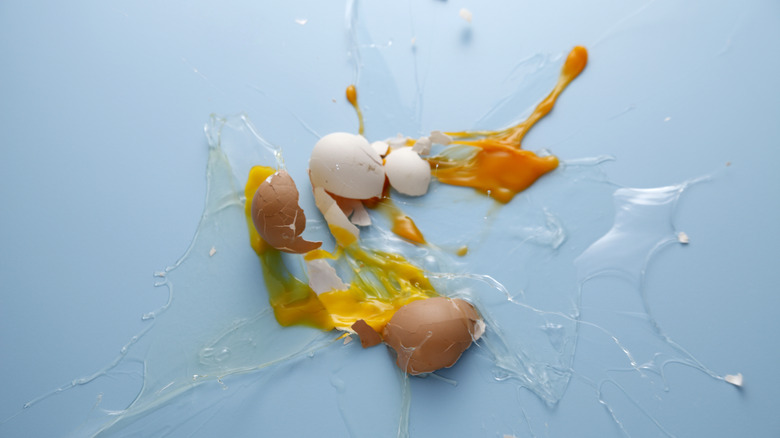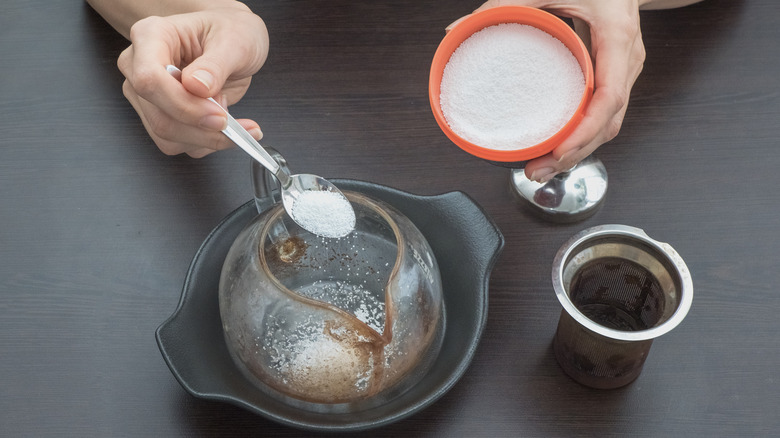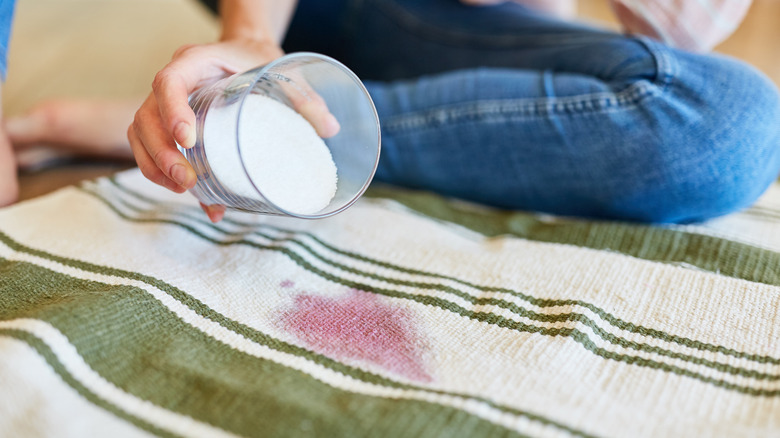The Salt Trick To Easily Clean Up Smashed Eggs
For many of us, salt is always within arm's length when cooking, and we're constantly refilling the container beside the stove. Salt enhances the way food tastes without imparting new flavors like other spices. It increases the ingredient's intensity, making fruit sweeter and chocolate more chocolatey. While salt is indispensable for cooking, it has other uses that (forgive us) make it 'worth its weight in salt.' While you can clean your kitchen with just apple cider vinegar, to make cleaning up goopy eggs easier, turn to something else.
The next time you crack an egg and the white dribbles onto the counter, or you drop the entire thing on the floor, stop swearing and reach for the salt shaker to easily clean the mess. Instead of chasing a blob of spilled eggs, salt makes cleaning it up a breeze, preventing you from spreading germs around the kitchen and contaminating the sponge.
There are many types of salt, but this is the ideal job for inexpensive table salt, not pricey sea salt. Simply pour a generous amount of salt over the entire spill, ensuring you cover every slimy drop of egg. Allow the salt to sit, absorbing the liquid (while keeping pets and small children away). Depending on the spill's size and how many eggs were lost in the accident, this can take 60 seconds to a few minutes. Once the surface is dry, brush the mess into the garbage or grab it with a paper towel and disinfect the surface.
Additional uses for salt around the kitchen
Salt is a natural antibacterial used to preserve food for centuries. It is still used to salt-cure meat and create an inhospitable environment for bacteria in pickled veggies. Those properties, along with its abrasive texture, make it ideal for cleaning everyday surfaces in the kitchen.
Add four teaspoons of salt, a cup of water, and crushed ice to coffee pots, tea kettles, and mugs to remove tough stains. Swishing the contents for a few seconds will scrub away the grim. Once the surface is clean, rinse and reuse.
To sanitize the wooden cutting board that's a fixture on the counter, sprinkle salt and use half a lemon to scrub the surface. Allow the salt to penetrate for a few minutes before rinsing it with water. The DIY cleaner will remove discoloration and bacteria from the wood, making it safe to cut raw fruit and veggies again. Once a month, follow up with a food-grade oil to keep expensive cutting boards in good shape.
Salt can also clean copper pots and brass surfaces by removing tarnish. Make a paste of equal parts salt and white distilled vinegar, or cover the cut side of half a lemon with salt to scrub the surface until you restore the metal's shine. Be sure to rinse all the salt off the surface and thoroughly dry the piece before storing.
More uses for salt around the house
In addition to being abrasive, salt's dehydrating superpower enables it to pick up more than slimy eggs. Salt can be used to lift wine, fruit juice, grease, dirt, and even Thanksgiving gravy stains from clothing, rugs, and tablecloths.
For wine, fruit juice, and grease stains, immediately blot the area with a paper towel to remove excess liquid. Cover the stain with salt and allow it to sit for a few minutes, absorbing the spill from the fabric. Don't be stingy with the salt. If the item can be laundered, wash it in cold water. To remove wine spills and muddy boot marks on carpets and other materials you can't throw in the washing machine, use salt to absorb the wet mess, similar to the smashed egg. Once it does, vacuum the surface, lifting the ugly stain.
Salt can also be used on wooden surfaces to remove watermarks and heat rings. Gently rub watermarks with a salt and water paste until the circle disappears, then polish the furniture to look new. Similarly, when the dishtowel doesn't sufficiently protect the table from the tray of lasagna, make a paste of olive oil and salt. Work it into the stain, and allow the salt and oil to penetrate for an hour, then remove the salt with a soft cloth. Viola! There should be salt shakers in every room in the house.



